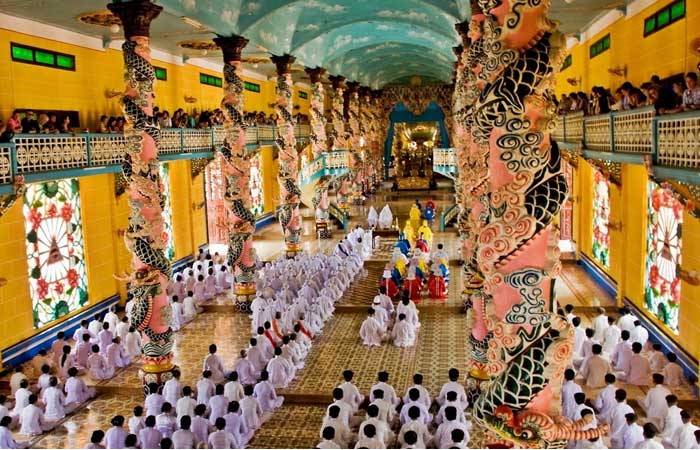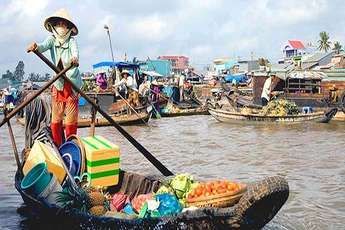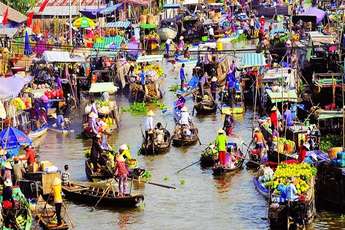
Cao Dai Temple, Holy See of Caodaism in Tay Ninh
- on Dec 6, 2019 By: BN
Nicknamed "holy land" in the south of the country, Tay Ninh attracts not only pilgrims but also many visitors who came to know Caodaism, a recent religion and it’s Holy See, an unusual architectural work. Founded in Vietnam in the early 20th century, it aims to cultivate religious life based on charity, humanity and morality. This effectively contributes to the appreciation of religious diversity and beliefs in the country. The Cao Dai temple is really worth visiting in the vicinity of Ho Chi Minh City and the Mekong Delta.
History of religion Cao Dai or Caodaism

Caodaism became an official religion in 1926 at Go Ken Pagoda, Hoa Thanh District, Tay Ninh Province. Ngo Minh Chieu, its founding father, was a senior official who ran the Phu Quoc Island District from 1920 to 1924 before becoming his first pope. The clergy welcomed both men and women, with nearly five million followers in Tay Ninh and the Mekong Delta. His influence was generally felt throughout southern and central Vietnam.
"Cao Dai" which literally means a high tower or supreme palace or God. His symbol is a divine eye that embodies everything in the depths of the human soul. In addition to the key characters of Caodaism including the founder of Buddhism, the saints, goddess and Chinese personalities, you will also find illustrious Western spirits like Joan of Arc, Descartes, Napoleon, Pastor, Shakespeare and Lenin...
The architecture of the Grand Temple

Its area of 40km² is dominated by some 100 buildings that make up an architectural ensemble of great originality, unique of its kind in Vietnam. A divine eye, the supreme symbol of Caodaism looks at you from the entrance gate, but it’s also in the stained glass windows inside. The site has twelve entrances, all of which are decorated with sculptures of four sacred animals of Asian belief and lotus. In a spacious courtyard, you will walk around the Buddha statues and lush gardens before reaching the Great Temple which is 93m long and 22m wide. This imposing building is characterized by three 36m high towers and two 25m tall pavilions sheltering steeples and drums.

The structure of the Great Cao Dai Temple rests on nine levels to symbolise the nine steps leading to paradise. At the bottom of the sanctuary, eight plaster columns carved with multi-coloured dragons support the dome representing paradise. Under the dome, what attracts visitors is a huge sphere decorated with more than three thousand stars each evoking a globe. It is on this sphere that the divine eye imposes itself. In the main hall, there are seven seats, the largest of which is reserved for the pope. The next three are those responsible for religious books while the last three are responsible for the three branches of Caodaism, represented by the colours yellow, blue and red.

On the aesthetic side, this sumptuous building owes its special shape to the vision of bringing together the world's major religions, Buddhism, Christianity, Taoism, Confucianism, Islam and Hinduism. You will see it at first sight with a remarkable mix of a cathedral, pagoda and Islamic mosque styles. A large fresco in the lobby highlights the personalities of the sect, like the Chinese revolutionary and statesman Sun Yatsen, the Vietnamese scholar Nguyen Binh Khiem and the great writer Victor Hugo.
When to visit the Cao Dai Temple?
Prayers are held daily at 6 AM, noon, 6 PM and midnight, of which the one at noon is the most appreciated by travellers. Note that women sit on the left of the altar and the men on the right. The visit requires a discreet and decent outfit. Do not forget to take off your shoes and hat before entering.

Caodaism Festival in Tay Ninh
The 9th day of the 1st month and the full moon day of the 8th month of the lunar calendar are the two biggest festivals of the Cao Dai Temple. The holy land of the south welcomes on these occasions thousands of followers and visitors who come in many to soak up a festive atmosphere of a thousand and one flavours overflowing with fruit.
The Cao Dai temple itself is worth a visit around Saigon and Mekong Delta to admire an original architectural work and feel the solemnity of the colourful and strictly organised ceremonies of a religion founded by the Vietnamese.
Location: Hoa Thanh District, Tay Ninh Province, more than 80km from Ho Chi Minh City. To get there, take the national roads 22 to 22B north-west.
Related articles:
>> Excursion to the Mekong Delta in 2, 3, 4 or 5 days, what to do?
Comment
Other Blog
Categories
Latest News
on 27 Apr, 2023      
on 15 Apr, 2023      
on 28 Mar, 2023      
 Español
Español Français
Français



















F
on Jan 3, 2024Igor Mozetic
on Apr 8, 2023Ira Beale
on Feb 10, 2023Phạm Phú Toàn
on Jan 28, 2023Max Stover
on Jan 11, 2023